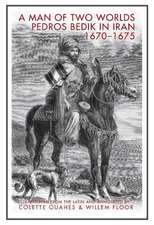Guilds, Merchants, and Ulama in Nineteenth-Century Iran
Autor Willem Flooren Limba Engleză Paperback – 31 mar 2009
Preț: 303.92 lei
Preț vechi: 329.37 lei
-8% Nou
Puncte Express: 456
Preț estimativ în valută:
58.17€ • 63.21$ • 48.90£
58.17€ • 63.21$ • 48.90£
Carte disponibilă
Livrare economică 31 martie-14 aprilie
Preluare comenzi: 021 569.72.76
Specificații
ISBN-13: 9781933823317
ISBN-10: 1933823313
Pagini: 280
Ilustrații: b/w illus
Dimensiuni: 210 x 279 x 15 mm
Greutate: 0.64 kg
Ediția:New.
Editura: MAGE PUBL INC
ISBN-10: 1933823313
Pagini: 280
Ilustrații: b/w illus
Dimensiuni: 210 x 279 x 15 mm
Greutate: 0.64 kg
Ediția:New.
Editura: MAGE PUBL INC























